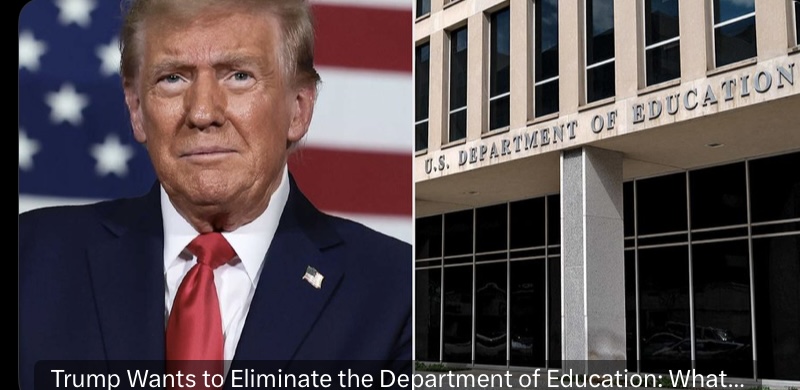NFL
BREAKING: Trump’s Plan to Shut Down the Department of Education: How It Could Reshape Public School Policies, Teacher Regulations, and Student Funding Nationwide

Trump Wants to Eliminate the Department of Education: What That Means for American Schools
Former President Donald Trump has reignited calls to abolish the U.S. Department of Education, a proposal that has long been popular among conservatives who argue for more local control over education. If enacted, such a move would mark one of the most significant shifts in American education policy in decades, raising questions about funding, curriculum standards, and the future of federal education programs.
Why Does Trump Want to Eliminate the Department of Education?
Trump and other critics of the Department of Education argue that education should be controlled by state and local governments, rather than by federal bureaucrats. They believe that eliminating the department would:
• Reduce federal oversight and regulation, giving states and school districts more autonomy.
• Decrease government spending by cutting administrative costs.
• Empower parents to have more control over their children’s education, particularly in areas such as school choice and curriculum decisions.
During his 2024 presidential campaign, Trump has vowed to dismantle the department as part of his broader effort to reduce the size of the federal government. “We are going to bring education back to the states where it belongs,” he stated in a recent speech.
What Does the Department of Education Do?
The U.S. Department of Education, established in 1979, oversees key aspects of the nation’s education system, including:
• Federal funding: The department distributes billions of dollars in federal aid to schools, including Title I funding for low-income students and grants for special education.
• Student loans and financial aid: It administers federal student loan programs and Pell Grants, which help millions of students afford higher education.
• Civil rights enforcement: It ensures that schools comply with federal laws related to discrimination, disability accommodations, and equal access to education.
• Education standards and research: It collects data, conducts research, and sets national education goals and guidelines.
Potential Consequences of Eliminating the Department of Education
If Trump were successful in abolishing the department, the impact on American schools could be profound. Some of the potential consequences include:
1. Loss of Federal Funding for Schools
One of the biggest concerns is the loss of billions in federal funding that many schools rely on. Programs such as Title I, which supports schools in low-income communities, could be severely impacted. Without federal oversight, funding disparities between wealthy and poor districts could widen.
2. Uncertainty for Student Loans and Financial Aid
The Department of Education plays a critical role in administering federal student aid. If the department were dismantled, it’s unclear who would take over these responsibilities or how college students would access financial aid programs.
3. Greater Variability in Education Standards
Without a federal agency overseeing education policies, states would have full control over curriculum standards and assessments. While some argue this would lead to greater innovation, others worry it could lead to significant disparities in educational quality across different states.
4. Impact on Civil Rights Protections
The Department of Education’s Office for Civil Rights ensures that schools comply with federal laws protecting students from discrimination based on race, gender, or disability. Eliminating the department could weaken enforcement of these protections, potentially affecting vulnerable student populations.
Would Congress Support This Move?
Even if Trump wins the presidency again, eliminating the Department of Education would require congressional approval, making it a challenging task. Many lawmakers, including some Republicans, have expressed skepticism about completely dismantling the department, as doing so could create logistical and legal challenges.
Additionally, past efforts to abolish the department have failed, even under Republican administrations that supported the idea. Instead, many conservatives have focused on reforming federal education policies rather than eliminating the department entirely.
What Comes Next?
Trump’s proposal has reignited debates about the role of the federal government in education. If the Department of Education were to be abolished, responsibility for education would shift entirely to states, which could lead to a patchwork system with significant disparities in resources and standards.
As the 2024 election approaches, education policy will likely remain a key issue. Whether Trump’s plan gains traction will depend on political dynamics, congressional support, and public opinion.
Conclusion
The future of the Department of Education remains uncertain, but Trump’s push to eliminate it has sparked renewed discussion about the balance of power between federal and state governments in education. While some see this as an opportunity for greater local control, others fear it could lead to funding shortfalls and a decline in education quality. Regardless of the outcome, the debate over the role of the federal government in education is far from over.












